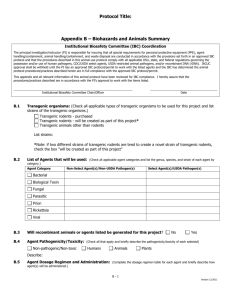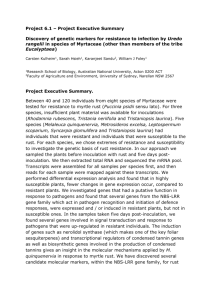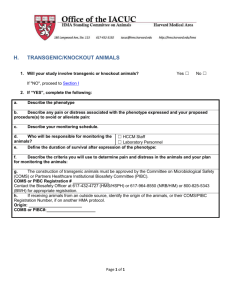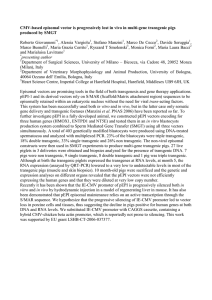Jessica K Plant Disease Resistance
advertisement
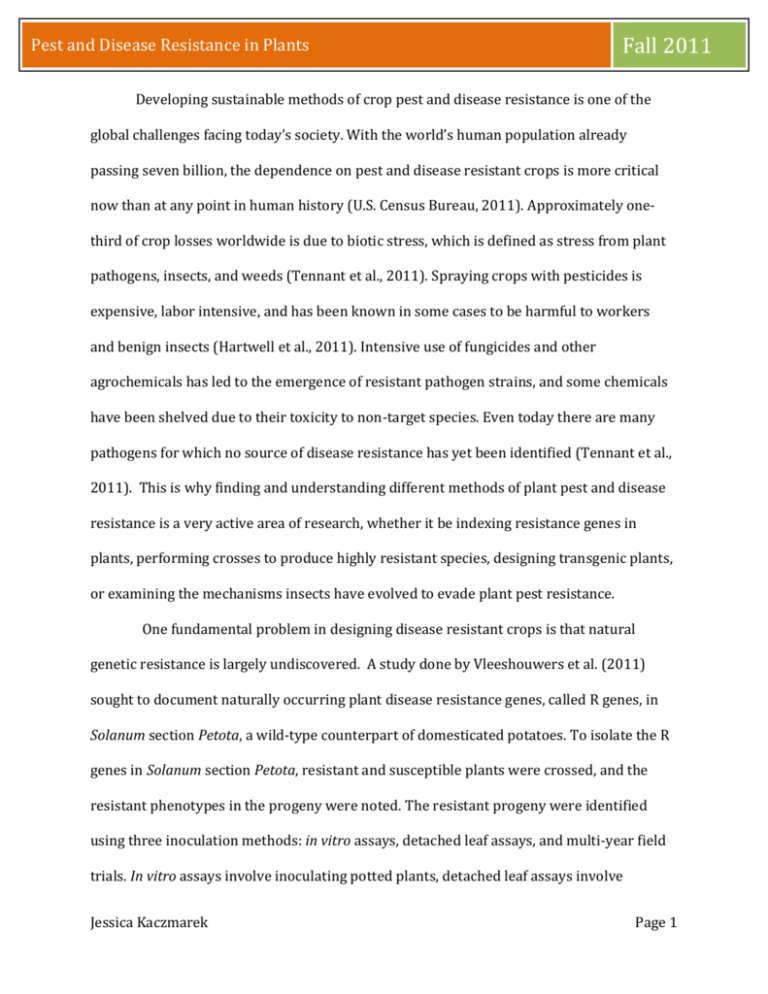
Pest and Disease Resistance in Plants Fall 2011 Developing sustainable methods of crop pest and disease resistance is one of the global challenges facing today’s society. With the world’s human population already passing seven billion, the dependence on pest and disease resistant crops is more critical now than at any point in human history (U.S. Census Bureau, 2011). Approximately onethird of crop losses worldwide is due to biotic stress, which is defined as stress from plant pathogens, insects, and weeds (Tennant et al., 2011). Spraying crops with pesticides is expensive, labor intensive, and has been known in some cases to be harmful to workers and benign insects (Hartwell et al., 2011). Intensive use of fungicides and other agrochemicals has led to the emergence of resistant pathogen strains, and some chemicals have been shelved due to their toxicity to non-target species. Even today there are many pathogens for which no source of disease resistance has yet been identified (Tennant et al., 2011). This is why finding and understanding different methods of plant pest and disease resistance is a very active area of research, whether it be indexing resistance genes in plants, performing crosses to produce highly resistant species, designing transgenic plants, or examining the mechanisms insects have evolved to evade plant pest resistance. One fundamental problem in designing disease resistant crops is that natural genetic resistance is largely undiscovered. A study done by Vleeshouwers et al. (2011) sought to document naturally occurring plant disease resistance genes, called R genes, in Solanum section Petota, a wild-type counterpart of domesticated potatoes. To isolate the R genes in Solanum section Petota, resistant and susceptible plants were crossed, and the resistant phenotypes in the progeny were noted. The resistant progeny were identified using three inoculation methods: in vitro assays, detached leaf assays, and multi-year field trials. In vitro assays involve inoculating potted plants, detached leaf assays involve Jessica Kaczmarek Page 1 Pest and Disease Resistance in Plants Fall 2011 inoculating individual leaves, and multi-year field trials involve inoculation over an extended period of time. The resistant phenotypes found were subjected to genetic mapping and R gene isolation to identify the R genes. Documenting the presence of R genes in Solanum section Petota allows potato breeders to use these data to introgress, or incorporate, desired disease-resistant traits from wild potatoes into their crop potatoes (Vleeshouwers et al., 2011). Introgression is a type of gene flow, and it is different from hybridization. Hybridization involves the one-time mating of two different but closely related species, producing a new variety that does not breed “true” and is usually sexually nonviable. Introgression is the stable integration of a transgene into a genome through several generations of crosses. Introgression is relatively rare in the wild because it involves backcrossing a successful, sexually viable transgenic hybrid with one of the nontransgenic plants in the parental population. An example should clarify what introgression is and its difference from hybridization. Canola is a transgenic crop that grows widely in North America. Canola’s wild relative is field mustard, and field mustard-canola hybrids do form a small percentage of progeny in the wild. Introgression requires the field mustardcanola hybrid to backcross with one of the two parental populations, say field mustard, several consecutive times in order for the transgene to be stably incorporated into the field mustard genome (Stewart, 2008). Introgressions are a way to increase the genetic diversity of resistance for crop breeding programs via the meshing-in of fresh genetic material from a different, closely related species. Inbreeding is a huge problem in domesticated crops and the gradual decrease in genetic diversity can lead to resistant pathogen strains. In western China in 2002, a new strain of stripe rust, a disease caused by P. Striiformis (Pst), caused a 1.3 Jessica Kaczmarek Page 2 Pest and Disease Resistance in Plants Fall 2011 million metric ton loss of common wheat. The new strain of disease, called CYR32, was immune to existing resistance genes used in China’s wheat breeding program. Genes resistant to CYR32 were found in P. huashanica, a wild relative of wheat. In a study by Kang et al. (2011), amphiploid hybrids between common wheat and P. huashanica were synthesized. Amphiploid organisms have two sets of chromosomes, with each set coming from a different species. Amphiploid production was used because it was a faster way of introgressing stripe rust resistance into the cultivated wheat. In Kang’s study, the introgressed lines and the two parental lines were taken to the greenhouse and point inoculated to determine stripe rust reaction. Figure 1 below shows the phenotypic results of the inoculation. Figure 1: Symptoms after four weeks of CYR32 inoculation “1” was a susceptible control for stripe rust disease response tests; “2” was P. huashanica, the wild wheat relative resistant to stripe rust; “3” was the ineffectively “disease resistant” domesticated wheat cultivar; “4” through “7” were the synthesized introgressed lines, and demonstrated high levels of CYR32 resistance (there is an absence of browning). The goal of the study was to test the effectiveness of using introgression of genetic resources in China’s wheat breeding programs (Kang et al., 2011). Jessica Kaczmarek Page 3 Pest and Disease Resistance in Plants Fall 2011 Engineering disease resistant plants can also be done by taking genes from other organisms and incorporating them into the plant genome. In the paper by Zhou et al. (2011), the goal was to create a transgenic turfgrass resistant to two fungal pathogens known to cause severe browning in turfgrass. It was known that a gene from the Atlantic white shrimp Litopenaeus setiferus coded for Penaeidin4-1 (Pen 4-1), a class of antimicrobial peptides characterized by its antimicrobial properties. Pen4-1 has a high level of toxicity against fungi, and is known to inhibit the growth of multi-drug resistant fungal species. A DNA construct containing the Pen4-1 sequence was prepared and transgenic turfgrass was created through Agrobacterium-mediated transformation. Agrobacterium-mediated transformation involves cutting turfgrass leaves into 1cm by 1cm pieces and soaking the leaves in Agrobacterium fluid for ten minutes. Plant cells along the cut take up the Agrobacterium plasmid containing the Pen4-1 construct. Plants are unique to genetic researchers because under the right conditions, the leaf bits can be planted and will regrow with the new DNA construct inserted into their genome. Transformation runs a very low risk of disrupting the genes and regulatory sequences at the transgene integration site because of non-coding regions within the turfgrass genome. In vitro and in vivo experiments were performed to see if the transgenic turfgrass containing the Pen4-1 construct was effective against the fungal pathogens causing dollar spot and brown patch, the two major diseases affecting turfgrass. Figure 2 on the next page shows the results of the in vitro plant leaf inoculation assay using R. solani, the fungus that causes brown patch. Jessica Kaczmarek Page 4 Pest and Disease Resistance in Plants Fall 2011 Figure 2: In vitro plant leaf inoculation R. solani (brown patch) In Figure 2, “WT” represents the wild-type turfgrass, which is the non-transgenic strain. “TG” represents the transgenic strain. Susceptibility to R. solani was measured quantitatively by recording the length of the lesions, or brown spots, on the leaves. It was noted that the transgenic turfgrass showed less browning than its wild-type counterpart when subjected to inoculation, suggesting the effectiveness of Pen4-1 against fungal pathogens like R. solani. In vivo direct plant inoculation assays supported this observation. Figure 3 shows the results of the in vivo assay. Figure 3: In vivo direct plant inoculation R. solani (brown patch) The top image in (a) shows the plants before pathogen infection. The bottom panel in (a) shows examples of plants two weeks after inoculation. Panel (b) compares lesion size of the wild-type and transgenic plants. The development of the brown patch disease was rated by measuring the lesion diameter two weeks after inoculation. Panel (b) clearly Jessica Kaczmarek Page 5 Fall 2011 Pest and Disease Resistance in Plants shows that the lesion diameter in the transgenic plant is smaller than that of the wild-type plant. In vitro and in vivo inoculation assays were also performed using R. homoeocarpa, the fungus that causes dollar spot disease. Similar results were obtained from these assays, with the transgenic plants exhibiting less severe symptoms of the disease than the wildtype control (Zhou et al., 2011). Creating pest-resistant crops is an interesting application of genetics and has had some commercial success already. For the past thirty years, organic farmers have taken advantage of a protein-based mechanism evolved by a common soil bacterium called Bacillus thuringiensis (Bt). Bt has around one dozen genes that code for crystalline (CRY) polypeptides that act as endotoxins. The endotoxins protect the microbe from being eaten by the same caterpillars that eat crops. When a caterpillar ingests the bacteria, the CRY proteins bind to specific intestinal sites, disrupting digestion and killing the insect rapidly. The CRY protein is highly specific to proteins found in moth and butterfly larvae. Even high dosages of CRY proteins are not toxic to birds, mammals, reptiles, or amphibians, suggesting that the Bt genes would be highly effective against pests (and safe for human consumption) if incorporated into crop genomes (Hartwell et al., 2011). One study showing the effectiveness of the CRY proteins against insect pests was done by Moghaieb et al. (2010). The stem borer is the most damaging pest to rice fields in the Egyptian Nile Delta (see Figure 4). Figure 4: Stem borer (Estes, 2004) In order to test rice plant resistance to the stem borer, a gene taken from Bt called cry1Ia5 was introduced into the rice plants. Three transgenic lines and a control were tested for insecticidal activity. Four days after the lines were infested with stem borer Jessica Kaczmarek Page 6 Pest and Disease Resistance in Plants Fall 2011 larvae, no surviving larvae were found on the transgenic lines, whereas on the control plants all the recovered larvae were found to be alive and healthy. Since transgenic plants showed high resistance to stem borer larvae, they serve as potential germplasms (genetic resources) in rice breeding programs (Moghaieb et al., 2010). Despite the commercial success of Bt transgenic crops in warding off insect pests, less is known about what causes insects to become resistant to pest-resistant crops. Insect resistance is associated with the inability of the CRY protein to bind to the intestinal membrane of the insect. In insect resistance, the toxic CRY protein is unable to form a transmembrane pore that lyses the epithelial cells along the intestinal tract; the intestinal cells of the insect leak, which is the cause of death. In a paper by Gahan et al. (2010), it was found that mutations within the genes coding for a transporter called ABCC2 of the cotton pest Heliothis virescens are responsible for the loss of binding of the Cry1Ac toxin to the insect’s intestinal wall. The mutated ABCC2 transporter is unable to incorporate the Cry1Ac toxin pore into the membrane; thus, the intestinal cells do not break open. Although the authors concluded that the pathways through which the Cry1Ac toxin can interact with the proteins along the intestinal wall are more complex than originally thought, it is important for scientists to investigate how pests develop resistance to bioinsecticides like the Cry1Ac protein before Bt transgenic crops become ineffective against pests. It is interesting to note the paradigm mentioned in the Gahan study that insects with resistance to pesticides suffer what is known as a “fitness cost” – that is, the price to pay for resistance to bioinsecticides is a reduction in fitness when the pesticide is absent. This weakness could be potentially exploited as another pest-management mechanism in future studies (Gahan et al., 2010). Jessica Kaczmarek Page 7 Fall 2011 Pest and Disease Resistance in Plants References Estes, Kelly, and Dawn Refsell (2004) What’s in Your Weeds? Part I. The Bulletin, University of Illinois Extension. Issue No. 12, Article 8. http://bulletin.ipm.illinois.edu/article.php?id=121. Accessed 30 October 2011. Gahan LJ, Pauchet Y, Vogel H, Heckel DG (2010) An ABC Transporter Mutation is Correlated with Insect Resistance to Bacillus thuringiensis Cry1Ac Toxin. PLoS Genet 6(12): e1001248. doi:10.1371/journal.pgen.1001248. Hartwell, Leland, et al. (2011). Genetics: From Genes to Genomes, Fourth Edition. New York: McGraw-Hill. pp. 304-305. Kang H, Wang Y, Fedak G, Cao W, Zhang H, et al. (2011) Introgression of Chromosome 3Ns from Psathyrostachys huashanica into Wheat Specifying Resistance to Stripe Rust. PLoS ONE 6(7): e21802. doi:10.1371/journal.pone.0021802. Moghaieb, Reda E.A. (2010) Transgenic rice plants expressing cry1Ia5 gene are resistant to stem borer (Chilo agamemnon). Landes Bioscience, Volume 1 Issue 5. pp. 288293.Stewart, Jr., C. Neal. (2008) Gene Flow and the Risk of Transgene Spread. University of Tennessee. Updated 8 March 2008. Accessed 29 October 2011. http://agribiotech.info/details/Stewart-GeneFlow%20Mar%208%20-%2003.pdf. Tennant, Paula F., Latanya C. Fisher, and Wayne A. McLaughlin. Disease-resistant transgenic crops: priorities and strategies for the Caribbean. Knowledge for Development: Observatory on Science and Technology. Published 30 June 2010. Accessed 29 October 2011. http://knowledge.cta.int/index.php/en/layout/set/print/content/view/full/12028 U.S. Census Bureau, Population Division. U.S. & World Population Clocks. Last Revised 29 June 2011. Accessed 29 October 2011. http://www.census.gov/main/www/popclock.html. Vleeshouwers, et al. SoIRgene: an online database to explore disease resistance genes in tuber-bearing Solanum species. BMC Plant Biology 2011, 11:116 http://www.biomedcentral.com/1471-2229/11/116 (18 August 2011). Zhou M, Hu Q, Li Z, Chen C-F, et al. (2011) Expression of a Novel Antimicrobial Peptide Penaeidin4-1 in Creeping Bentgrass (Agrostis stolonifera L.) Enhances Fungal Disease Resistance. PLoS ONE 6(9): e24677. doi:10.1371/journal.pone.0024677. Jessica Kaczmarek Page 8




